Simultaneous Multi-Channel Microwave Photonic Signal Processing
Abstract
:1. Introduction
2. Photonic Generation of Chirped Microwave Waveforms
2.1. General Considerations
2.2. Photonic Generation of Chirped Microwave Waveforms Using Superimposed LCFBGs
2.3. Photonic Generation of Chirped Microwave Waveforms Using an Arrayed Waveguide Grating Sagnac Interferometer
2.4. Discussion
3. Photonic Radio-Frequency Spectrum Analysis
3.1. Context
3.2. Integrated Mode-Selective Nonlinear Device
3.3. Bandwidth Measurements
3.4. Multi-Channel Results
3.5. Discussion
4. Conclusions
Acknowledgments
Author Contributions
Conflicts of Interest
References
- Capmany, J.; Novak, D. Microwave photonics combines two worlds. Nat. Photonics 2007, 1, 319–330. [Google Scholar] [CrossRef]
- Yao, J.P. Microwave photonics. IEEE/OSA J. Lightw. Technol. 2009, 27, 314–335. [Google Scholar] [CrossRef]
- Iezekiel, S.; Burla, M.; Klamkin, J.; Marpaung, D.; Capmany, J. RF engineering meets optoelectronics. IEEE Microw. Mag. 2015, 16, 28–45. [Google Scholar] [CrossRef]
- Yao, J.P. Photonic generation of microwave arbitrary waveforms. Opt. Commun. 2011, 284, 3723–3736. [Google Scholar] [CrossRef]
- Rashidinejad, A.; Li, Y.; Weiner, A.M. Recent Advances in Programmable Photonic-Assisted Ultrabroadband Radio-Frequency Arbitrary Waveform Generation. IEEE J. Quantum Electron. 2016, 52, 1–17. [Google Scholar] [CrossRef] [Green Version]
- Capmany, J.; Mora, J.; Gasulla, I.; Sancho, J.; Lloret, J.; Sales, S. Microwave photonic signal processing. IEEE/OSA J. Lightw. Technol. 2013, 31, 571–586. [Google Scholar] [CrossRef]
- Minasian, R.A.; Chan, E.W.H.; Yi, X. Microwave photonic signal processing. Opt. Express 2013, 21, 22918–22936. [Google Scholar] [CrossRef] [PubMed]
- Ng, W. Photonics for microwave systems and ultra-wideband signal processing. Opt. Commun. 2016, 373, 2–15. [Google Scholar] [CrossRef]
- Jiang, H.; Marpaung, D.; Pagani, M.; Vu, K.; Choi, D.-Y.; Madden, S.J.; Yan, L.; Eggleton, B.J. Wide-range, high-precision multiple microwave frequency measurement using a chip-based photonic Brillouin filter. Optica 2016, 3, 30–34. [Google Scholar] [CrossRef]
- Pan, S.; Yao, J.P. Photonics-based broadband microwave measurement. IEEE/OSA J. Lightw. Technol. 2017, 35, 3498–3513. [Google Scholar] [CrossRef]
- Zmuda, H.; Toughlian, E.N. Photonic Aspects of Modern Radar; Artech House: Norwood, MA, USA, 1994. [Google Scholar]
- Dorrer, C.; Maywar, D.N. RF Spectrum Analysis of Optical Signals Using Nonlinear Optics. J. Light. Technol. 2004, 22, 266–274. [Google Scholar] [CrossRef]
- Pelusi, M.; Luan, F.; Vo, T.D.; Lamont, M.R.E.; Madden, S.J.; Bulla, D.A.; Choi, D.-Y.; Luther-Davies, B.; Eggleton, B.J. Photonic-chip-based radio-frequency spectrum analyser with terahertz bandwidth. Nat. Photonics 2009, 3, 139–143. [Google Scholar] [CrossRef]
- Vo, T.D.; Pelusi, M.D.; Schröder, J.; Luan, F.; Madden, S.J.; Choi, D.Y.; Bulla, D.A.P.; Luther-Davies, B.; Eggleton, B.J. Simultaneous multi-impairment monitoring of 640 Gb/s signals using photonic chip based RF spectrum analyzer. Opt. Express 2010, 18, 3938–3945. [Google Scholar] [CrossRef] [PubMed]
- Corcoran, B.; Vo, T.D.; Pelusi, M.D.; Monat, C.; Xu, D.-X.; Densmore, A.; Ma, R.; Janz, S.; Moss, D.J.; Eggleton, B.J. Silicon nanowire based radio-frequency spectrum analyzer. Opt. Express 2010, 18, 20190–20200. [Google Scholar] [CrossRef] [PubMed]
- Vo, T.D.; Corcoran, B.; Schroder, J.; Pelusi, M.D.; Xu, D.X.; Densmore, A.; Ma, R.; Janz, S.; Moss, D.J.; Eggleton, B.J. Silicon-chip-based real-time dispersion monitoring for 640 Gbit/s DPSK signals. IEEE/OSA J. Lightw. Technol. 2011, 29, 1790–1796. [Google Scholar] [CrossRef]
- Ferrera, M.; Reimer, C.; Pasquazi, A.; Peccianti, M.; Clerici, M.; Caspani, L.; Chu, S.T.; Little, B.E.; Morandotti, R.; Moss, D.J. CMOS compatible integrated all-optical radio frequency spectrum analyzer. Opt. Express 2014, 22, 21488–21498. [Google Scholar] [CrossRef] [PubMed]
- Weiner, A.M. Optical pulse shaping: A tutorial review. Opt. Commun. 2011, 284, 3669–3692. [Google Scholar] [CrossRef]
- Chen, L.R. Photonic generation of chirped microwave and millimeter wave pulses based on optical spectral shaping and wavelength-to-time mapping in silicon photonics. Opt. Commun. 2016, 373, 70–81. [Google Scholar] [CrossRef]
- Wang, C.; Yao, J.P. Photonic generation of chirped millimeter-wave pulses based on nonlinear frequency-to-time mapping in a nonlinearly chirped fiber Bragg grating. IEEE Trans. Microw. Theory Tech. 2008, 56, 542–553. [Google Scholar] [CrossRef]
- Chi, H.; Yao, J.P. Chirped RF pulse generation based on optical spectral shaping and wavelength-to-time mapping using a nonlinearly chirped fiber Bragg grating. IEEE/OSA J. Lightw. Technol. 2008, 26, 1282–1287. [Google Scholar] [CrossRef]
- Wang, C.; Yao, J.P. Simultaneous optical spectral shaping and wavelength-to-time mapping for photonic microwave arbitrary waveform generation. IEEE Photonics Technol. Lett. 2009, 21, 793–795. [Google Scholar] [CrossRef]
- Spasojevic, M.; Chen, L.R. Discretely tunable optical delay lines using serial and step-chirped sidewall Bragg gratings in SOI. Electron. Lett. 2013, 49, 608–610. [Google Scholar] [CrossRef]
- Wang, C.; Yao, J.P. Photonic generation of chirped microwave pulses using superimposed chirped fiber Bragg gratings. IEEE Photonics Technol. Lett. 2008, 20, 882–884. [Google Scholar] [CrossRef]
- Ma, M.; Rochette, M.; Chen, L.R. Generating chirped microwave pulses using an integrated distributed Fabry–Pérot cavity in silicon-on-insulator. IEEE Photonics J. 2015, 7, 5500706. [Google Scholar] [CrossRef]
- Zhang, W.; Yao, J.P. Photonic generation of linearly chirped microwave waveforms using a silicon-based on-chip spectral shaper incorporating two linearly chirped waveguide Bragg gratings. IEEE/OSA J. Lightw. Technol. 2015, 33, 5047–5054. [Google Scholar] [CrossRef]
- Zhang, W.; Yao, J.P. Silicon-based on-chip electrically-tunable spectral shaper for continuous tunable linearly chirped microwave waveform generation. IEEE/OSA J. Lightw. Technol. 2016, 34, 4644–4672. [Google Scholar] [CrossRef]
- Wang, C.; Yao, J. Chirped microwave pulse generation based on optical spectral shaping and wavelength-to-time mapping using a Sagnac loop mirror incorporating a chirped fiber Bragg grating. IEEE/OSA J. Lightw. Technol. 2009, 27, 3336–3341. [Google Scholar] [CrossRef]
- Wang, J.; Ashrafi, R.; Rochette, M.; Chen, L.R. Chirped microwave pulse generation using an integrated silicon photonic spectral shaper. IEEE Photonics Technol. Lett. 2015, 27, 1876–1879. [Google Scholar] [CrossRef]
- Shu, X.; Yu, L.; Zhao, D.; Zhang, L.; Sugden, K.; Bennion, I. Transmission characteristics of Sagnac interferometers based on fiber Bragg gratings. J. Opt. Soc. Am. B 2002, 19, 2770–2780. [Google Scholar] [CrossRef]
- Moslemi, P.; Chen, L.R. Simultaneously generating multiple chirped microwave pulses with superimposed FBGs. IEEE Photonics Technol. Lett. 2017, 29, 1387–1390. [Google Scholar] [CrossRef]
- Capmany, J.; Muñoz, P.; Sales, S.; Pastor, D.; Ortega, B.; Martinez, A. Arrayed waveguide Sagnac interferometer. Opt. Lett. 2003, 28, 197–199. [Google Scholar] [CrossRef] [PubMed]
- Moslemi, P.; Chen, L.R.; Rochette, M. Simultaneously generating multiple chirped microwave waveforms using an arrayed waveguide Sagnac interferometer. IET Electron. Lett. 2017, 53, 1534–1535. [Google Scholar] [CrossRef]
- Bolger, J.A.; Littler, I.C.M.; Eggleton, B.J. Optimization of superimposed chirped fiber Bragg gratings for the generation of ultra-high speed optical pulse trains. Opt. Commun. 2007, 271, 524–531. [Google Scholar] [CrossRef]
- Shahoei, H.; Li, M.; Yao, J. Continuously tunable time delay using an optically pumped linear chirped fiber Bragg grating. IEEE/OSA J. Lightw. Technol. 2011, 29, 1465–1472. [Google Scholar] [CrossRef]
- Cheung, S.; Su, T.; Okamoto, K.; Yoo, S.J.B. Ultra-compact silicon photonic 512 × 512 25 GHz arrayed waveguide grating router. IEEE J. Sel. Top. Quantum Electron. 2014, 20, 8202207. [Google Scholar] [CrossRef]
- Burla, M.; Cortés, L.R.; Li, M.; Wang, X.; Chrostowski, L.; Azaña, J. Integrated waveguide Bragg gratings for microwave photonics signal processing. Opt. Express 2013, 21, 25120–25147. [Google Scholar] [CrossRef] [PubMed]
- LaRochelle, S.; Simard, A.D. Silicon photonic Bragg grating devices. In Proceedings of the Conference on Optical Fiber Communication, Los Angeles, CA, USA, 19–23 March 2017. [Google Scholar]
- Provost, L.; Parmigiani, F.; Petropoulos, P.; Richardson, D.J. Investigation of simultaneous 2R regeneration of two 40-Gb/s channels in a single optical fiber. IEEE Photonics Technol. Lett. 2008, 20, 270–272. [Google Scholar] [CrossRef]
- Provost, L.; Parmigiani, F.; Petropoulos, P.; Richardson, D.J.; Mukasa, K.; Takahashi, M.; Hiroishi, J.; Tadakuma, M. Investigation of four-wavelength regenerator using polarization- and direction-multiplexing. IEEE Photonics Technol. Lett. 2008, 20, 1676–1678. [Google Scholar] [CrossRef]
- Ding, Y.; Xu, J.; Ou, H.; Peucheret, C. Mode-selective wavelength conversion based on four-wave mixing in a multimode silicon waveguide. Opt. Express 2014, 22, 127–135. [Google Scholar] [CrossRef] [PubMed]
- Ma, M.; Chen, L.R. Harnessing mode-selective nonlinear optics for on-chip multi-channel all-optical signal processing. APL Photonics 2016, 1, 086104. [Google Scholar] [CrossRef]
- Ma, M.; Adams, R.; Chen, L.R. Integrated photonic chip enabled simultaneous multi-channel ultra-wideband radio frequency spectrum analyzer. IEEE/OSA J. Lightw. Technol. 2017, 35, 2622–2628. [Google Scholar] [CrossRef]
- Ding, Y.; Xu, J.; Da Ros, F.; Huang, B.; Ou, H.; Peucheret, C. On-chip two-mode division multiplexing using tapered directional coupler-based mode multiplexer and demultiplexer. Opt. Express 2013, 21, 10376–10382. [Google Scholar] [CrossRef] [PubMed]
- Wang, J.; He, S.; Dai, D. On-chip silicon 8-channel hybrid (de)multiplexer enabling simultaneous mode- and polarization-division-multiplexing. Laser Photonics Rev. 2014, 8, L18–L22. [Google Scholar] [CrossRef]
- Krückel, C.J.; Fülöp, A.; Klintberg, T.; Bengtsson, J.; Andrekson, P.A.; Torres-Company, V. Linear and nonlinear characterization of low-stress high confinement silicon-rich nitride waveguides. Opt. Express 2015, 23, 25827–25837. [Google Scholar] [CrossRef] [PubMed]
- Rezagholipour Dizaji, M.; Krückel, C.J.; Fülöp, A.; Andrekson, P.A.; Torres-Company, V.; Chen, L.R. Silicon-rich nitride waveguides for ultra-broadband nonlinear signal processing. Opt. Express 2017, 25, 12100–12108. [Google Scholar] [CrossRef] [PubMed]
- Samadi, P.; Chen, L.R.; Callender, C.L.; Dumais, P.; Jacob, S.; Celo, D. RF arbitrary waveform generation using tunable planar lightwave circuits. Opt. Commun. 2011, 284, 3737–3741. [Google Scholar] [CrossRef]
- Bui, L.A.; Pelusi, M.D.; Vo, T.D.; Sarkhosh, N.; Emami, H.; Eggleton, B.J.; Mitchell, A. Instantaneous frequency measurement system using optical mixing in highly nonlinear fiber. Opt. Express 2009, 17, 22983–22991. [Google Scholar] [CrossRef] [PubMed]
- Pagani, M.; Morrison, B.; Zhang, Y.; Casas-Bedoya, A.; Aalto, T.; Harjanne, M.; Kapulainen, M.; Eggleton, B.J.; Marpaung, D. Low-error and broadband microwave frequency measurement in a silicon chip. Optica 2015, 2, 751–756. [Google Scholar] [CrossRef]
- Pagani, M.; Vu, K.; Choi, D.-Y.; Madden, S.J.; Eggleton, B.J.; Marpaung, D. Instantaneous microwave frequency measurement using four-wave mixing in a chalcogenide chip. Opt. Commun. 2016, 373, 100–104. [Google Scholar] [CrossRef]
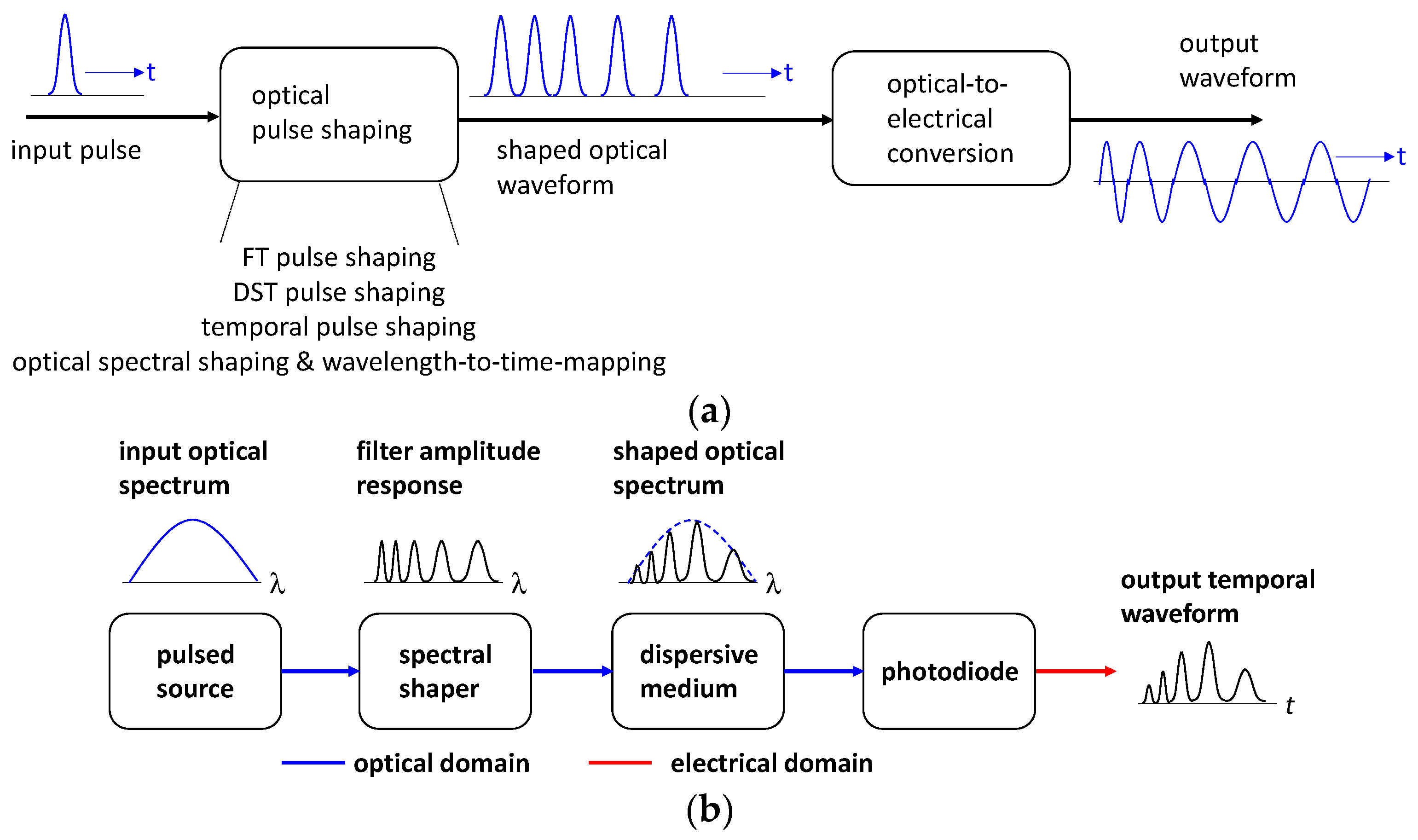
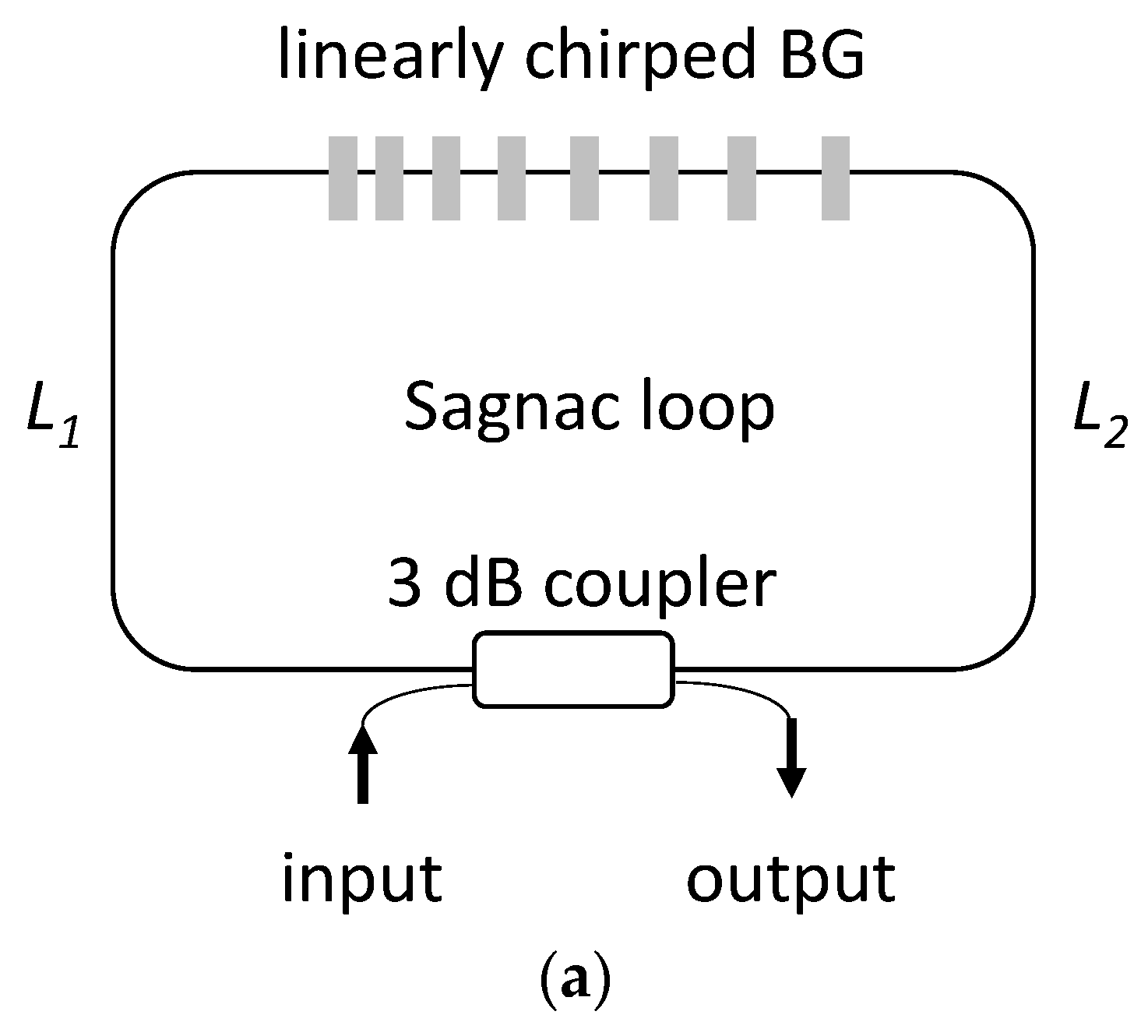
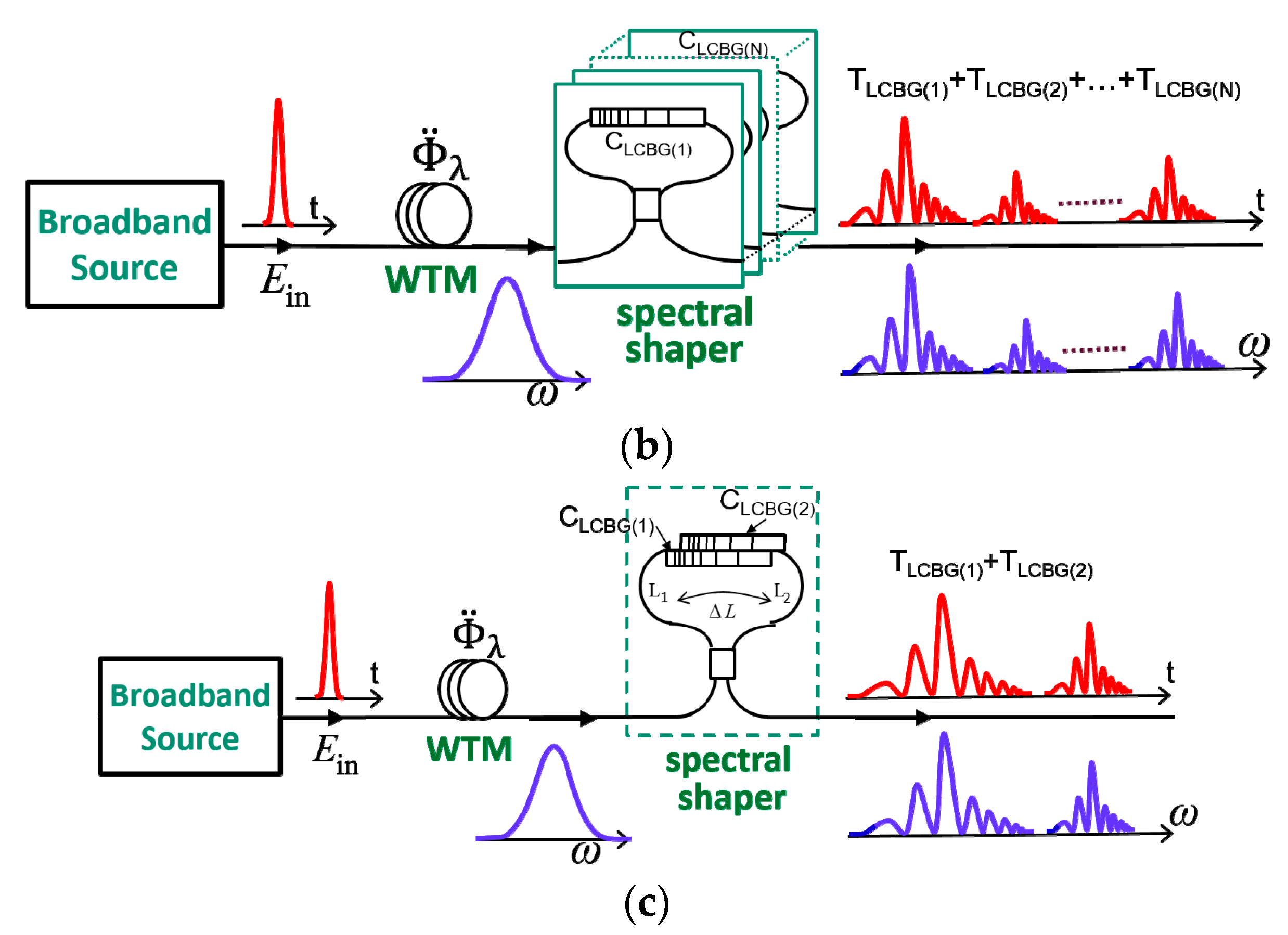

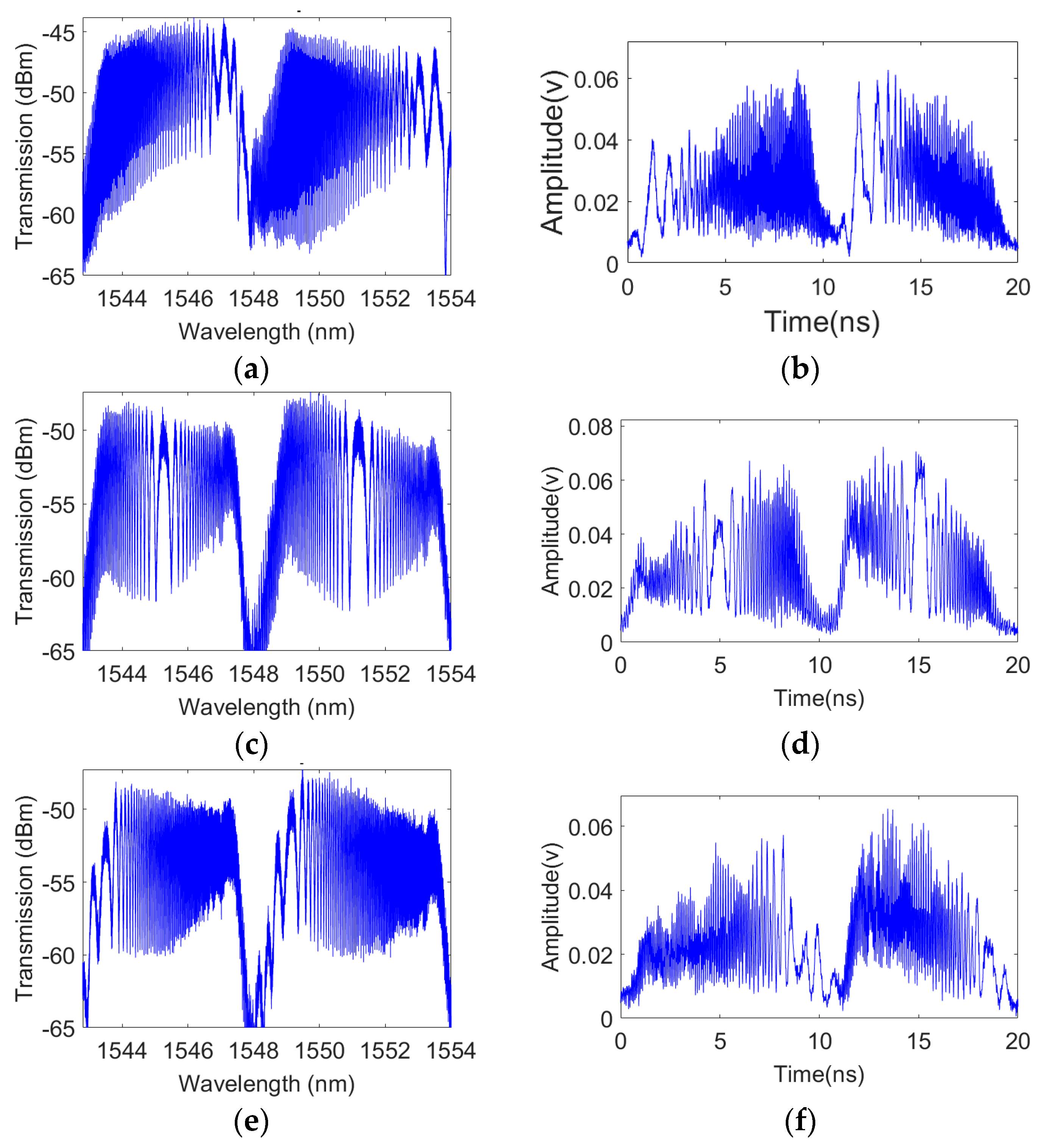

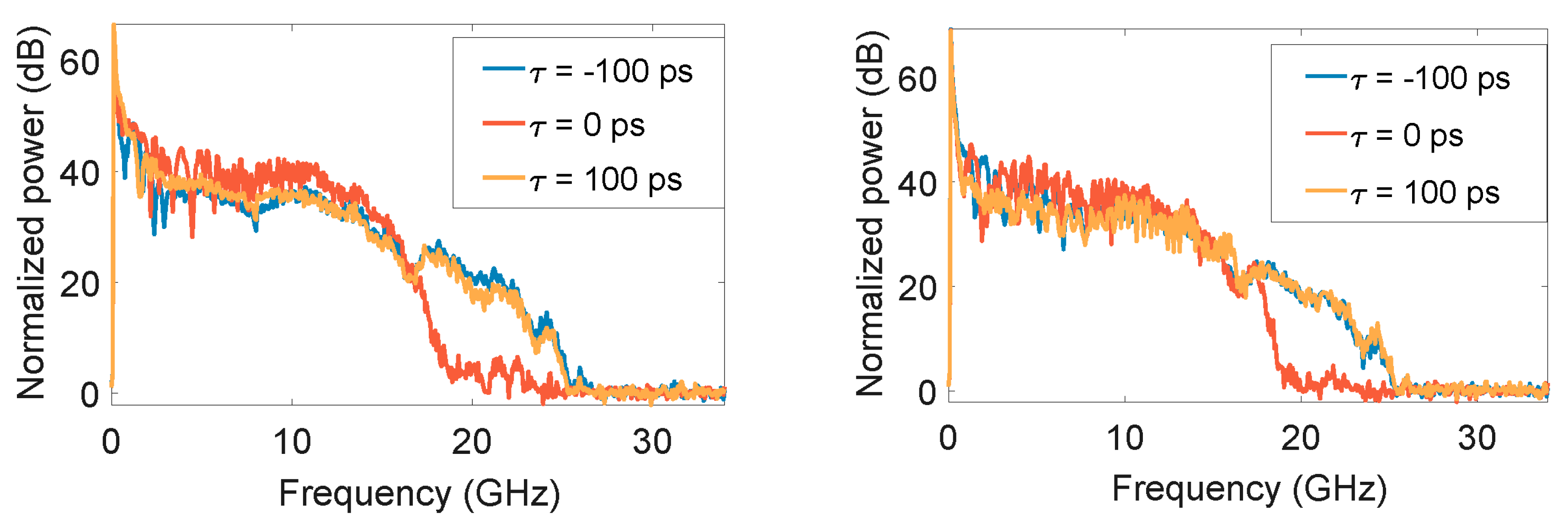

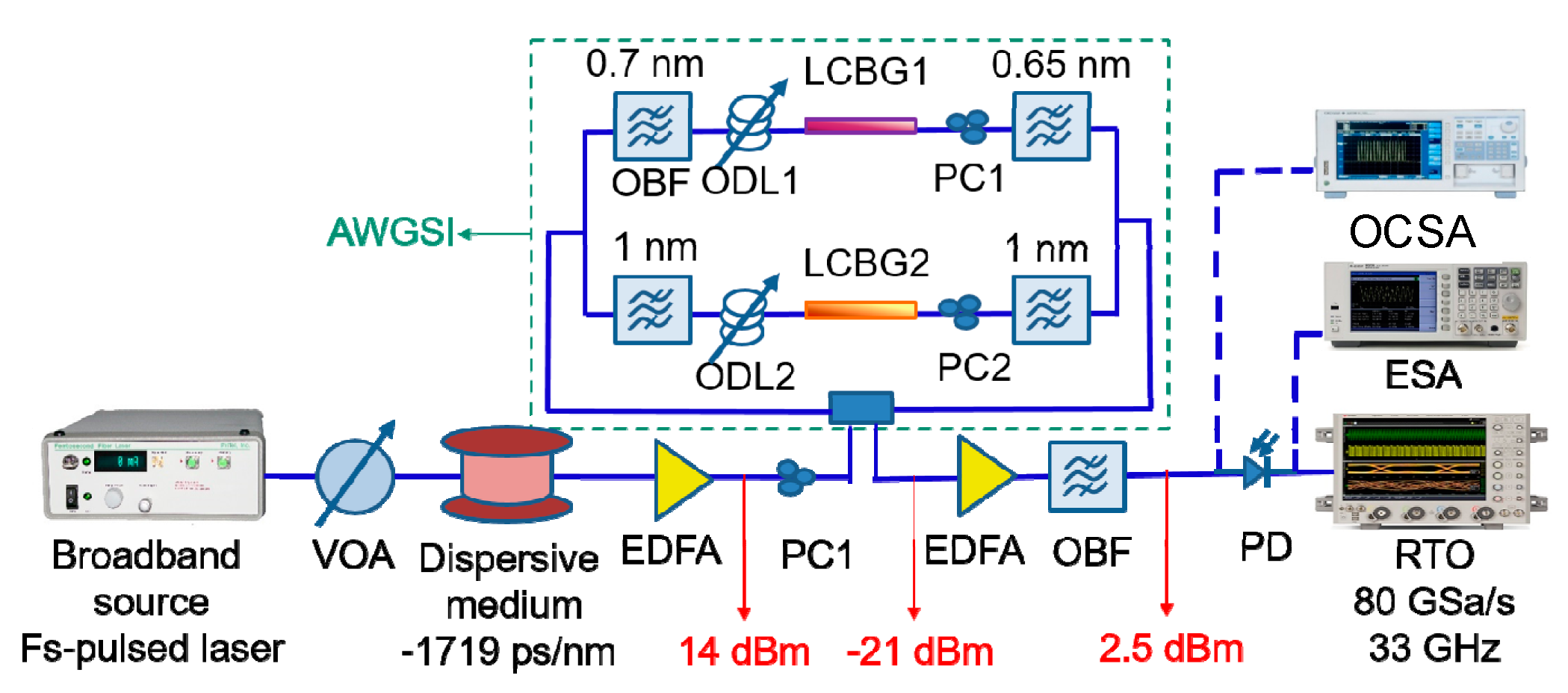
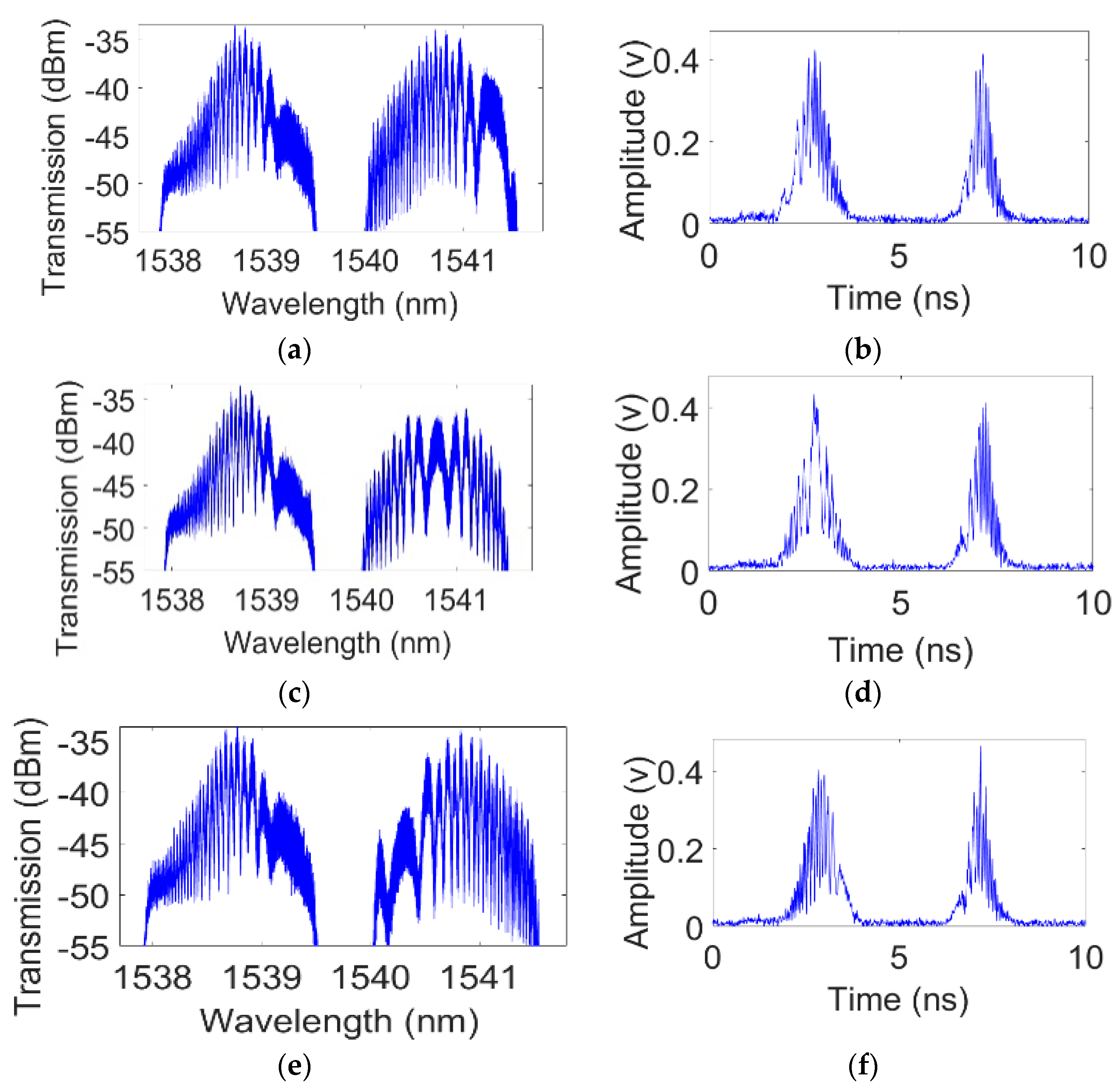
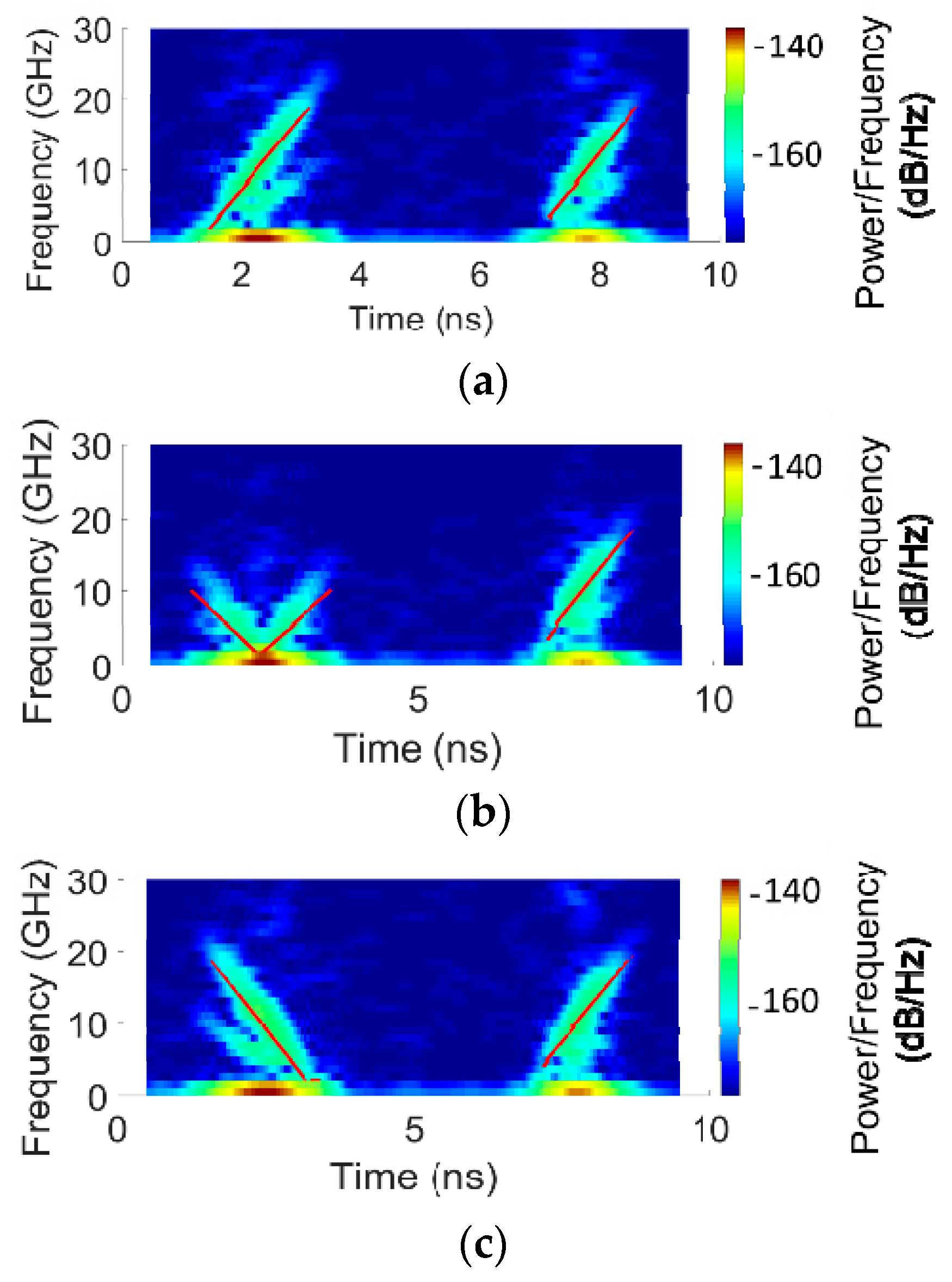
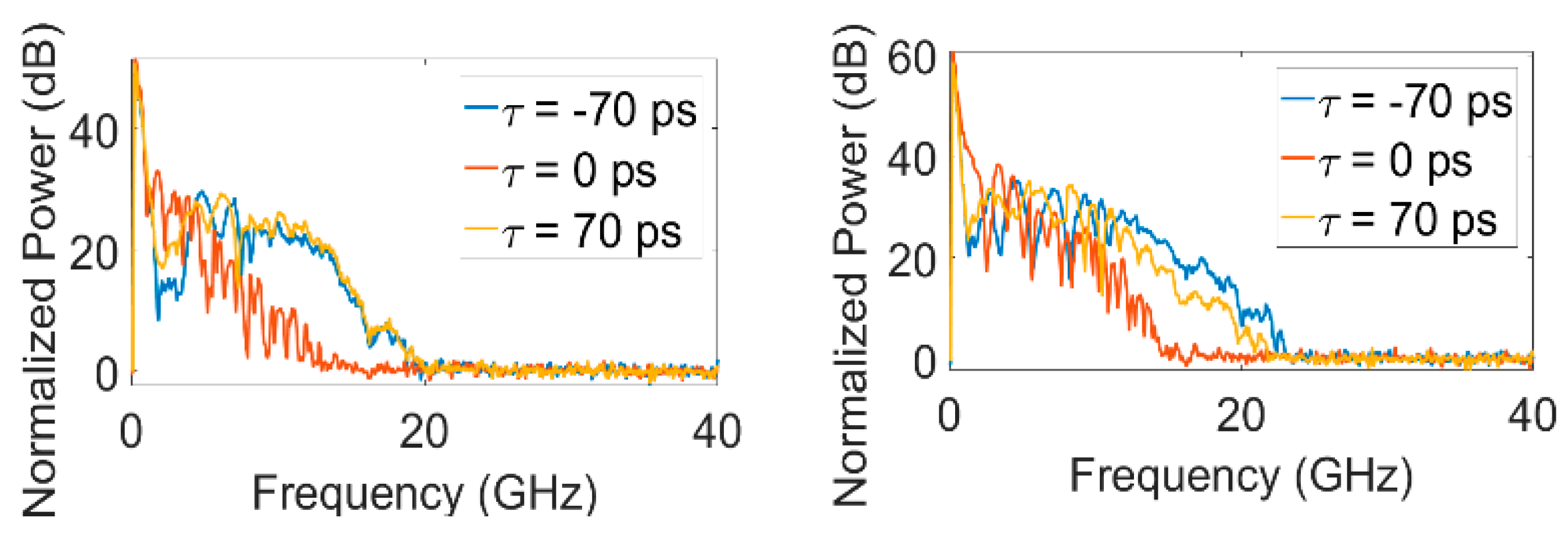




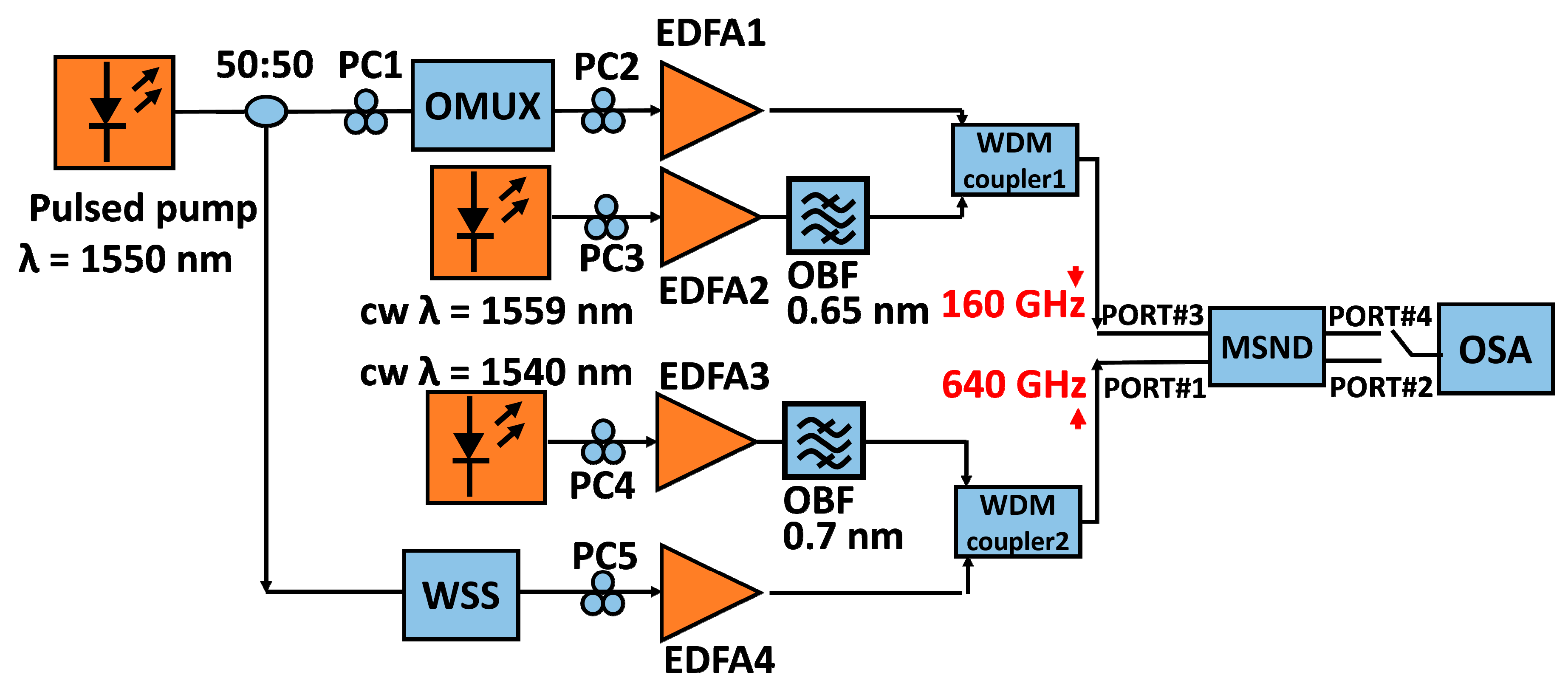
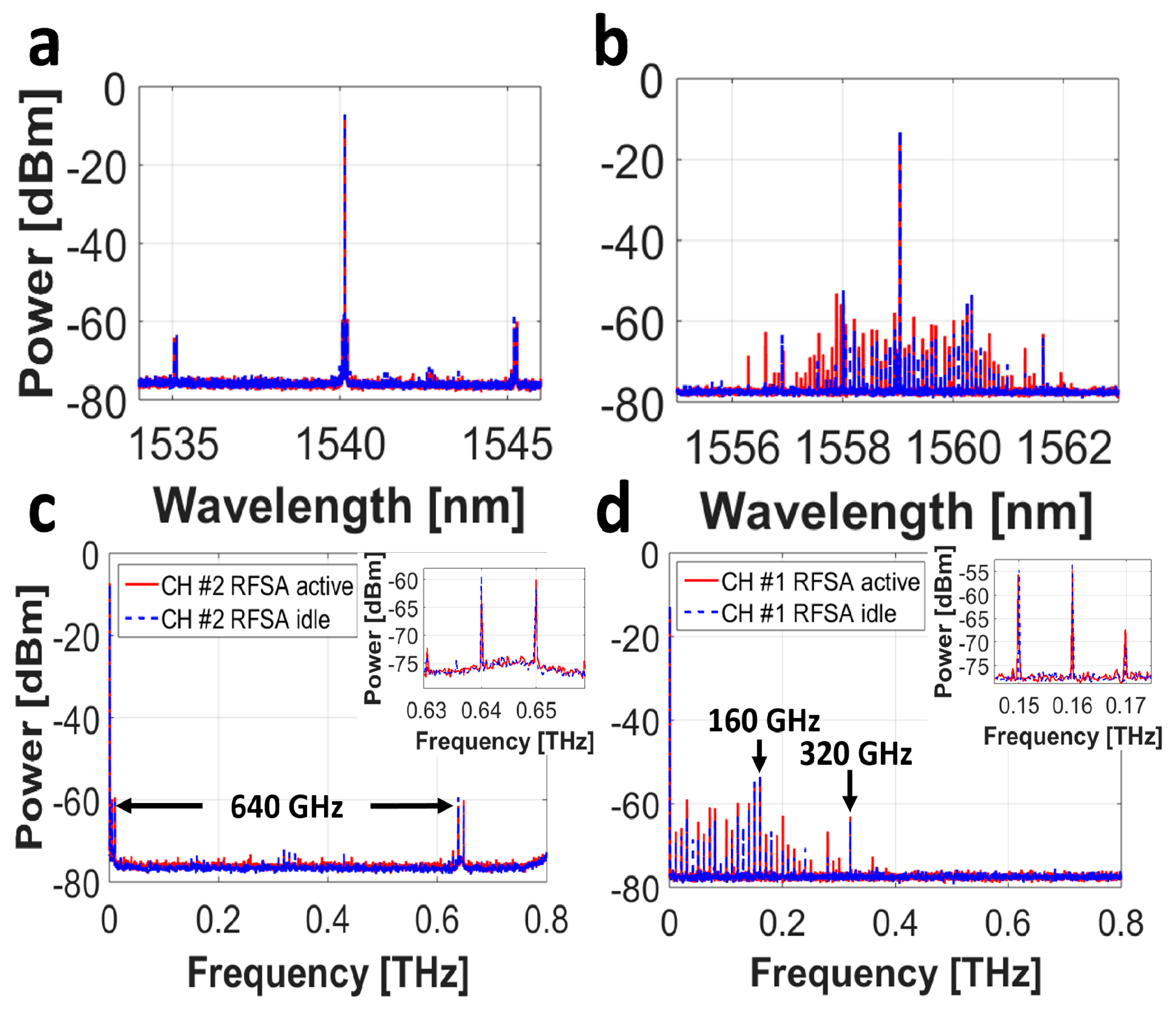
| Parameter | TE0 Mode | TE1 Mode |
|---|---|---|
| Dispersion @ 1550 nm, ps/(nm·cm) | −5.55 × 10−4 | 1.56 × 10−3 |
| Dispersion slope @ 1550 nm, ps/(nm·cm2) | 1.75 × 10−6 | −1.51 × 10−5 |
| Effective area, µm2 | 0.094 | 0.122 |
| Nonlinear parameter, m−1·W−1 | 194 | 150 |
© 2017 by the authors. Licensee MDPI, Basel, Switzerland. This article is an open access article distributed under the terms and conditions of the Creative Commons Attribution (CC BY) license (http://creativecommons.org/licenses/by/4.0/).
Share and Cite
Chen, L.R.; Moslemi, P.; Ma, M.; Adams, R. Simultaneous Multi-Channel Microwave Photonic Signal Processing. Photonics 2017, 4, 44. https://doi.org/10.3390/photonics4040044
Chen LR, Moslemi P, Ma M, Adams R. Simultaneous Multi-Channel Microwave Photonic Signal Processing. Photonics. 2017; 4(4):44. https://doi.org/10.3390/photonics4040044
Chicago/Turabian StyleChen, Lawrence R., Parisa Moslemi, Ming Ma, and Rhys Adams. 2017. "Simultaneous Multi-Channel Microwave Photonic Signal Processing" Photonics 4, no. 4: 44. https://doi.org/10.3390/photonics4040044





